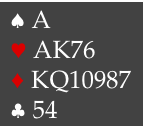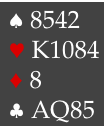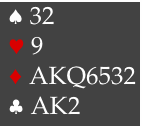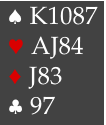
This week (March 15-25), the ACBL is running it’s Spring Nationals
. The Nationals are a 10 day long event, organized around the major US team- and pairs championships, but with dozens of other events available for players of all levels. On a typical day at the Nationals, one can start at 8:30 in morning with the morning game and play until somewhere in the early hours when the “midnite swiss” ends. On an average day, a 1000 tables are in play.
Even though I’m no longer playing Nationals myself, my schedule does change during those weeks. First, I log in in the morning to read the daily bulletin on the ACBL site to see who won and read about the interesting hands from the day before. Later in the day, I log in to BBO aka Bridgebase Online to watch the play in the major events.
Being able to watch play behind your computer is one of the biggest changes in reporting the game over the last 15 years. It used to take weeks before results were known and often months before a report appeared in a magazine. Nowadays, it is possible to watch most major events in real time and see experts from all over the world in action. Next Saturday one can, for example, follow live action from the Vanderbilt in the US, but also the Beijing Bridge Elite Invitational, the Indonesian championships in Bandung and the Belarus championships in Minsk. For the current schedule, click here, no special software is needed but you will have to sign up once for a free account.
The first major match that was ever broadcasted over the Internet, was the final of the 1996 Spingold in August of that year in Miami Beach, Florida, US. The broadcast was being organized by OKbridge. OKbridge had just introduced a replay feature in its software that allowed players to replay a hand on their screen while discussing play in the chat box in parallel. Somebody suggested to use that for the Spingold final and Matt Clegg, the owner of OKbridge, agreed. To get the show on the road took a bit of effort. First of all, one needed access to the Internet from the vuegraph room, not a usual request for the hotel staff back then. Then, hand records were not available electronically for outsiders, so as soon as a hand appeared on the vuegraph, an operator had to copy it and enter it by hand. That sometimes went wrong and one had a hand with 2 spade aces. US expert Karen Allison provided comments. OKbridge had a limit of 250 players at the table and I remember Matt saying that he thought that would be sufficient. He was wrong, 250 showed up on the first hand and the house was packed for the rest of the day. It probably helped lot that the final was an interesting match between the teams captained by Nickell and Schwartz, well played and decided on the last board.
I was one of the operators on that day. A voluntary job, but I did get a log file of the action during the day as a reward. Here are a few interesting problems from this file. Try them as a problem while waiting for the next vuegraph session to start.

1. In a conventional auction, with the opponents silent, you hear that your partner has either 5♣-4♦ or 4♣-5♦, 2 aces, the ♠K, and a minimum opening bid. The auction has reached the level of 5♠, now what?
Alternatively, try this problem at the other table. Again, partner shows a minimum opening bid but this time with specifically 5♣-4♦. Your RHO overcalled in spades. Again, 2 aces and the ♠K are shown. Now what?

2. White against red, you pick up this collection and hear 1♦ on your right. Natural, but limited to 16 hcp and practically denying a 4 card major. You double, pass, pass by partner converting it into penalties. Opener decides to run by redoubling, you pass, 1♠ on your left and 2 passes. Now what?

3. Pass from partner, 2♥ on your right (11-15, 4♠-5♥). You can bid 3♥ showing a running suit but denying stoppers in the majors, 4♥ on your left, pass, pass. Now what? And what do you bid if LHO continues with 5♥?

4. You get this hand and hear 1♠ on your right, partner passes, 2♦ on your left, 2NT from opener and 3NT on your left. The opponents play canape, which means that opener has shown exactly 4♠ in more or less balanced hand. He can still have 5 clubs though. Your lead?
Solutions later in the week. If you get all 4 right, I guess we’ll see you on Bridgebase sometime soon.



